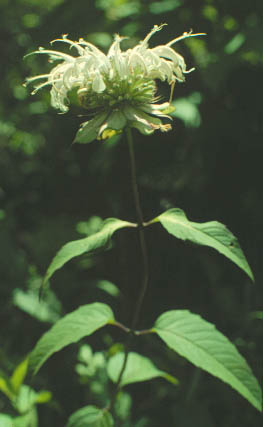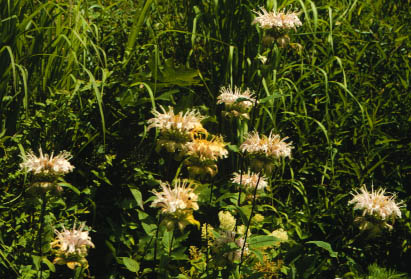
Monarda Clinopodia
Courtesy of the UGA Herbarium

Monarda Clinopodia
Courtesy of the UGA Herbarium
Monarda Clinopodia Courtesy of the UGA Herbarium |
Monarda Clinopodia Courtesy of the UGA Herbarium |
Author: Gwen Kathryn Ewald
Permanent E-Mail Address:gwenyth1@juno.com or gewald@arches.uga.edu
~~~~~~~~~~~~~~~~~~~~~~~~~~~~~~~~~~~~~~~~~~~~~~~~~~~~~~~~~~~~~~~~~~
:·
Higher Taxon·
Species List·
Identification Guide·
General Information·
Species M. didyma·
Species M. punctata·
References:Family: Lamiaceae (Labiatae)
Description: According to John Small the genus Monarda, commonly referred to as Horse-mints, consists of approximately twenty North American species(Small, 1933). In the Manual of the Southeastern Flora, Monarda is described as "Shrubs or perennial erect herbs. Leaf-blades toothed. Flowers in remote or approximate dense cymes. Calyx elongate, nearly regular: lobes 5, slender, shorter than tube. Corolla 2-lipped, elongate: upper lip narrow, erect or arched: lower lip 3-lobed, the middle lobe much longer than the lateral ones. Stamens 2: filaments elongate: anthers with divergent sacs."(Small, 1933).
Species List: A Species List for the genus Monarda displays the scientific and known common names for species within the genus. Variations and hybrids have been omitted, for a more complete list refer to the Gray Herbarium Index. You may also link directly to pages specific to M. didyma and M. punctata.
Identification Guide: The following identification key outlines the defining characteristics of the two subgenus and the species within the each. This key was taken from John Small's Manual of the Southeastern Flora:
"Flower-clusters terminal ad solitary: stamens exserted beyond the straight upper corolla-lip ..................................................................................Subgenus I. Eumonarda
Flower-clusters mainly auxillary, borne in spike-like interrupted panicles: Stamens not exceeding the curved
upper corolla lip ...........................................Subgenus II. Cheilyctis
Subgenus I. Eumonarda
Leaf-blades relatively long-petioled or manifestly petioled.
Corolla scarlet..........................................................1. M. didyma
Corolla white, pink or purple.
Leaf-blades membranous, deep-green: corolla greenish or cream-colored.............................................2.M.Clinopodia
Leaf-blades firmer, barely membranous, dull- or bright-green: corolla pink, purple or purple-red.
Pubescence of spreading hairs.
Corolla, and often the bracts, lilac or purplish
.........................................3. M. fistulosa
Corolla, and the bracts, deep-purple or purple-red. ...........4.M. media
Pubescence of very short appressed hairs.
Leaves on the upper part of the stem with petioles less than 5mm.long.
....................................................5. M. scabra
Leaves on the upper part of the stem with petioles over 5 mm.long.
..........................................................6. M. mollis
Leaf-blades sessile or nearly so: calyx pubescent at the mouth; lobes not glandular...........7. M. Bradburiana
Subgenus II. Cheilyctis
Plants perennial: calyx-lobes acuminate: corolla yellowish, or rarely white. .........................8. M. punctata
Plants annual or biennial: calyx-lobes setaceous: corolla pink or purplish. ........................9. M. dispersa"
(Small, 1933).
General Information: The genus Monarda is named in honor of the Spanish medical botanist, Dr. Nicholas Monardes of Seville (Bremness, 1988). Dr. Monardes wrote his herbal on American flora in the 1569 book, Joyful News Out of the Newe Founde Worlde (International Herb Association). Species in this genus are, because of their hardiness and beauty, often kept for ornamental purposes. The flower varieties range in color between white, purple, scarlet red, pink, and yellow and vary in shape and size. Monarda species grow in various habitats from near-desert to mountainous conditions and have a fragrant, sometimes spicy quality in their flowers and leaves (International Herb Association).
1. Bremness, Lesley. 1988. The Complete Book of Herbs. Viking Studio Books. New York, NY.
ISBN 0-670-81894-1.
2. Britannica Macropædia. 1998. v.25. Encyclopedia Britannica, Inc. Chicago, IL. ISBN 0-85229-633-0.
3.Coile, Nancy C. and Samuel B. Jones, Jr. 1985. The Georgia Plant List. The University of Georgia Herbarium.
Athens, GA.
4. Grieve, M. Botanical.com, A Modern Herbal. http://www.botanical.com/botanical/mgmh/m/mints-39.html
5.Grimm, William Carey. 1933. The Illustrated Book of Wildflowers and Shrubs. Stackpole Books. Harrisburg, PA.
ISBN 0-8117-3085-9.
6. International Herb Association web site: http://www.theherbaltouch.com/iha/monarda.html
7.Jones, Samuel B.,Jr. and Nancy C. Coile. Checklist of the Vascular Flora of Clarke County, Georgia. Palfrey Funds
of The University of Georgia Department of Botany. Athens, GA.
8. Klimas, John J. and James A. Cunningham. 1974. Wildflowers of Eastern America. Alfred A. Knopf, Inc. NY.
ISBN 0-394-49362-1.
9.Niering, William A. 1979. The Audubon Society Field Guide to North American Wildflowers: Eastern Region. Alfred
A. Knopf, Inc. NY. ISBN 0-394-50432-1.
10.Radford, Albert E., William C. Dickson, Jimmy R. Massey and C. Ritchie Bell. 1974. Vascular Plant Systematics.
Harper and Row, Publishers. New York, NY. ISBN 06-045309-5.
11. Shaw, Dr. Elizabeth A. 1968. Gray Herbarium Index. G.K. Hall and Co. Boston, MA.
12. Shimizu, Holly. 1997 Bee Balm. National Gardening Association.
http://www2.garden.org/nga/EDIT/Articles/beebalm.qua
13. Small, John Kunkel. 1933. Manual of the Southeastern Flora. New York, NY.
14. Steere, William C. Wildflowers of the United States: The Southeastern States. McGraw-Hill Book Co. NY.